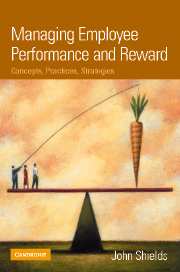Book contents
- Frontmatter
- Contents
- List of figures and tables
- Foreword by John Egan
- Acknowledgements
- Introduction: Setting the scene
- Part 1 The fundamentals
- 1 Performance and reward basics
- 2 Working with psychology
- 3 Managing motivation
- 4 Being strategic and getting fit
- Part 2 Performance management in action
- Part 3 Base pay and benefits
- Part 4 Rewarding employee performance
- Part 5 Fitting it all together
- Model responses to case studies
- References
- Index
4 - Being strategic and getting fit
from Part 1 - The fundamentals
- Frontmatter
- Contents
- List of figures and tables
- Foreword by John Egan
- Acknowledgements
- Introduction: Setting the scene
- Part 1 The fundamentals
- 1 Performance and reward basics
- 2 Working with psychology
- 3 Managing motivation
- 4 Being strategic and getting fit
- Part 2 Performance management in action
- Part 3 Base pay and benefits
- Part 4 Rewarding employee performance
- Part 5 Fitting it all together
- Model responses to case studies
- References
- Index
Summary
As noted in the introduction to part 2, the factors that shape behavioural outcomes are at once psychological and strategic, and the development, implementation and maintenance of effective performance and reward management systems requires simultaneous attention to both of these basic dimensions. By ‘strategic’ dimensions we mean the plans, processes and actions involved in establishing and maintaining alignment between an organisation's objectives, on the one hand, and the individual and collective capabilities, behaviour and results of its employees, on the other. In this final chapter on the conceptual foundations of performance and reward management, we explore what is involved in managing employee performance and rewards strategically.
To suggest that employee performance and rewards should be managed ‘strategically’ sounds eminently sensible; after all, you would hardly want to propose that an organisation should manage its people in a non-strategic way! But what does managing human resources ‘strategically’ really mean? In broad terms, it can be said that taking a strategic approach to people management requires the identification and application of those human resource management principles, policies and practices that best align with and support the strategic objectives of the organisation as a whole as well as those of the relevant division, department and/or business unit. How should an organisation go about shaping its performance and reward policies and practices so that they do elicit the capabilities or competencies, behaviour and results that the organisation says that it must have in order to be successful in achieving its objectives?
- Type
- Chapter
- Information
- Managing Employee Performance and RewardConcepts, Practices, Strategies, pp. 88 - 118Publisher: Cambridge University PressPrint publication year: 2007



